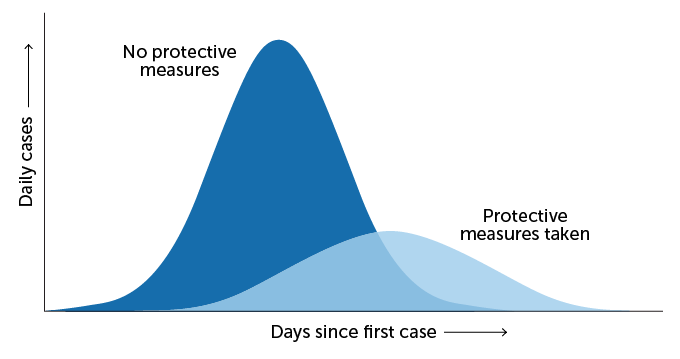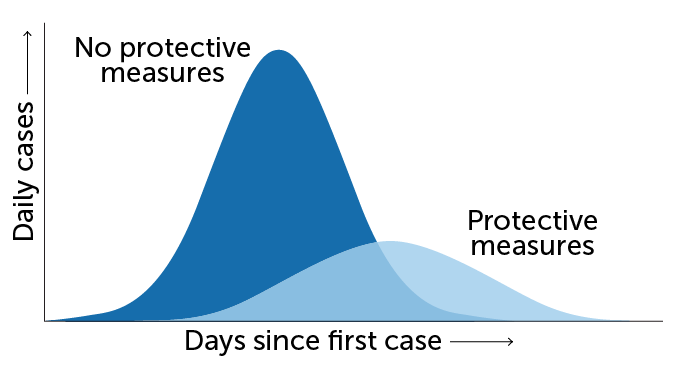Social distancing, not travel bans, is crucial to limiting coronavirus’ spread
Acting now to reduce the virus’ spread will help avoid worst-case scenarios

Health experts say social distancing measures like cancelling public gatherings are key to fighting the spread of the coronavirus. Some sports games, like this March 11 soccer match in Moenchengladbach, Germany, are now being played in stadiums without fans.
Martin Meissner/ASSOCIATED PRESS
By Jonathan Lambert and Tina Hesman Saey
- More than 2 years ago
Aggressive actions to prevent — or at least to slow — the spread of COVID-19 are being taken across the world. Universities are cancelling in-person classes, while academic conferences and political rallies are postponed. Shops are shuttering. Sports leagues are suspending seasons or competing in empty stadiums.
Such “social distancing” measures, as they are called by public health experts, are considered essential in controlling a viral pandemic (SN: 3/11/20). What’s not helpful at this point is banning travel from other affected countries, experts say, such as the U.S. ban on most European visitors announced March 11 by President Donald Trump.
“I recommend that people voluntarily cut back on non-essential travel” — a form of social distancing in that people would be avoiding crowded airports, train stations and bus depots, says Caitlin Rivers, an epidemiologist at the Johns Hopkins Center for Health Security. “But I do not expect that travel bans will meaningfully impact the trajectory of the outbreak.”
The virus is probably more widespread than we realize in the United States, partly because early problems with testing meant cases likely slipped by undetected (SN: 3/6/20). So U.S. health officials are most concerned now with limiting opportunities for transmission. That helps to prevent hospitals and clinics from becoming overwhelmed, as reportedly has happened in Italy as the number of confirmed cases shot beyond 10,000 in just two weeks.
Acting quickly to establish social distancing measures can “flatten the epidemic curve” of an outbreak, experts say. That means the outbreak spreads more slowly and reaches its peak later, with a lower number of active cases at the peak than if no preventive measures were taken.
Flattening the curve
As an epidemic progresses, cases grow exponentially before declining as the virus spreads through a population and people develop immunity. Without social distancing measures that limit opportunities for transmission, cases can spike quickly and outstrip the capacity of health systems. Social distancing measures, such as cancelling public gatherings and avoiding crowds, can slow the spread of the virus and spread cases out over a longer period of time, which can help hospitals provide care while avoiding being overwhelmed by patients.
Curve of epidemic disease incidence with and without protective measures


Source: CDC
“As a nation, we can’t be doing the kinds of things we were doing a few months ago,” such as gathering in large groups, Anthony Fauci, director of the National Institute of Allergy and Infectious Diseases in Bethesda, Md., said in a news conference March 10. If we don’t enact social distancing measures now, “we’re going to be weeks behind, and the horse is going to be out of the barn.”
Social distancing can take many forms. Individuals can wave hello instead of shaking hands, or avoid busy shops and crowds, in order to lower the risk of coming into contact with an infected person or contaminated surface. Communities can close schools or cancel public events. Social distancing isn’t an all-or-nothing endeavor. Even small actions, like washing your hands, can help flatten the curve, experts say.
But it’s not immediately clear how aggressive we need to be now, or how long social distancing measures should last. That’s because we still don’t have a good understanding of where the virus is or how it spreads. “These are serious unknowns, and it really complicates decision making,” Rivers says. “There are no straightforward answers.”
A tale of two cities
China’s outbreak offers some evidence of the benefits of early social distancing. In the provincial capital of Wuhan, where the virus was first detected in December, authorities waited six weeks after community spread had begun to forcibly quarantine the entire city of 8 million (SN:1/23/20). Still, nearly 20,000 needed hospitalization simultaneously in the city, including about 2,000 in need of critical care, each day during the local peak of the epidemic in February.
But in the Chinese port city of Guangzhou, officials closed schools, banned large gatherings and isolated people confirmed to have the virus within just a week of detecting the first case in that city. That rapid action meant Guangzhou has never had to hospitalize more than 300 people at a time so far during the outbreak. And the case fatality rate in Guangzhou has been 0.8 percent, compared with Wuhan’s 4.5 percent, according to a new study by Rivers and her colleagues that was posted online March 10 on Harvard University’s DASH research repository and has yet to be peer reviewed.
Health facilities in many U.S. cities could handle an outbreak like that in Guangzhou, but not like the one in Wuhan, Rivers says. That’s why “it’s very important that we act early and with appropriate intensity to reduce transmission,” she says. That also goes for young people, even though they are less at risk of developing serious illness. Young people “need to be worrying about it in the context of their larger community and thinking themselves as being part of that larger network,” she says.
This is especially important because infected people without any symptoms can still spread the virus to others. One study posted March 5 at medRxiv.org, where researchers share their work before it’s peer reviewed, estimated that roughly half of all virus transmissions in both Singapore and Tianjin, China, were from pre-symptomatic people..
Plus, the virus is “highly contagious,” says Clemens Wendtner, director of infectious disease and tropical medicine at the Munich Clinic Schwabing, a teaching hospital in Germany. Infected patients can shed large amounts of virus from their noses and throats and in coughed-up phlegm before they develop symptoms as well as in the first week of symptoms, Wendtner and colleagues report in another small study posted March 8 at medRxiv.org. “This would tell us that gatherings of people should be avoided,” he says.
Jump-starting social distancing
If people can transmit the virus before they are even aware that they are infected, measures like simply staying home if you’re feeling sick won’t be enough, says epidemiologist William Hanage at the Harvard T.H. Chan School of Public Health in Boston.
In the United States, “extreme interventions are going to be challenging, making it all the more important to start right away” with actions like cancelling public gatherings and asking people to work from home, Hanage says.
Communities also should prepare for schools closing, Hanage says. Though children don’t seem as vulnerable to the virus as adults, kids are just as likely to get infected, according to a study posted at medRxiv.org March 4. Past flu outbreaks, as well as mathematical simulations, have shown school closures to be effective in flattening the outbreak curve and buying time to boost the capacity of health care systems.
But closing schools comes with costs. Many kids rely on school for regular meals, and many parents can’t take time off of work to care for a kid forced to stay home. Some experts have argued that closing schools has limited social distancing benefits, since kids can still congregate outside of school. “These are difficult decisions, and communities should be planning now about how to meet the needs of children if schools have to close,” Hanage says.
But while social distancing aims to limit opportunities for a virus to spread, travel bans are designed to stop its introduction into a community in the first place. It’s far too late for that now in the United States, where the virus is almost certainly spreading undetected in the country, Hanage says.
“The great majority of new infections result from [community spread], not new introductions from elsewhere,” he says. “So any impact of a travel ban is negligible in comparison with social distancing.”
And that social distancing needs to happen now, even with scientists still working on determining how the disease spreads, how quickly it spreads and how deadly it really is, Hanage says. “We’re later in this outbreak than we think.”

Trustworthy journalism comes at a price.
Scientists and journalists share a core belief in questioning, observing and verifying to reach the truth. Science News reports on crucial research and discovery across science disciplines. We need your financial support to make it happen – every contribution makes a difference.







